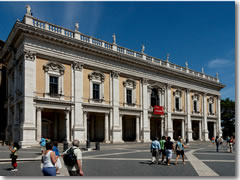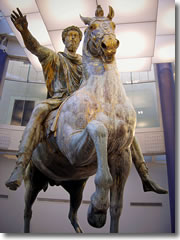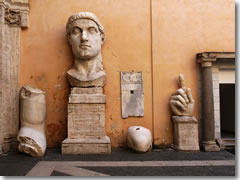
Since 2000, the two wings been connected by an underground tunnel through the famed Tabularium, the ancient Roman archives that were discovered just beneath the Palazzo Senatorio, where Rome's modern mayor still holds court.
As you stand in the Michelangelo-designed Piazza del Campidoglio atop the Capitoline Hill and face the middle palace, it is the two buildings on either side that together house the museum.
Unless they've changed it yet again, you now have to start with the building on your left, the Palazzo Nuovo half of the museum, filled with ancient sculpture such as the Dying Gaul, busts of ancient philosophers, the Mosaic of the Doves, and the Capitoline Venus.

The Palazzo Nuovo also contains, in a glassed-in portico just off the courtyard against one wall of which reclines the river god Marforio (traditionally one of Rome's famous "talking statues"), the original 2nd-century AD equestrian statue of Marcus Aurelius, which until 1981 stood on on the central pedestal of the Piazza del Campidoglio out front.
This gilded bronze original had been tossed into the Tiber in antiquity, and when Christians later fished it out, they mistakenly thought it was Constantine the Great, the first Christian emperor.
This misinterpretation for centuries saved it from being hacked to pieces as a pagan idol and earned it pride of place in the piazza atop the Capitoline Hill (until it was removed for restoration and—eventually—a copy was stuck there in its place).
That may merely induce a "so what?" shrug, but think about this: How many statues of famous men triumphantly riding horses you've seen scattered in cities around the world? Lots, right?
Well, this statue of Marcus Aurelius is the only ancient Roman equestrian statue to have survived the ages intact, and as such was the inspiration for every single one that came after it, serving as the touchstone for this now-common form of commemorative art.
(If that doesn't do it for you: the modern copy they stuck on the piazza outside was precision-made using lasers; cool.)
You no longer cross Piazza del Campidoglio to get from one branch of the museum to the other. Instead, you go underground to follow that Tabularium tunnel—diverging down the side corridor for a great view across the Roman Forum—to the museum’s other half, the Palazzo dei Conservatori.
Romulus, Remus, and the She-Wolf
Rome was legendarily founded by twin brothers, Romulus and Remus, who had been abandoned in the woods and raised by a she-wolf. Romulus later quarreled with and killed Remus à la Cain and Abel—which is why you're visiting "Rome" and not "Reme"—but that heroic she-wolf with the overactive motherly instincts became the most famous of the trio, and since ancient times has been the symbol of Rome itself and all the city and its Empire stands for.
The collections have their share of famous antique statuary:
The real stars of the collection, however, are the paintings.
The museum's second-floor pinacoteca (painting gallery) houses works by Il Guercino, Veronese, Titian, Tintoretto, Rubens, Pietro da Cortona, and two by Caravaggio—one of his Gypsy Fortune-Teller works and the scandalously erotic St. John the Baptist, in which the nubile young saint twists to embrace a ram and looks out at us coquettishly.

Odds are you've seen dozens of postcards all over Rome featuring cats lazing around on these giant marble body parts (or people posing goofily beside them).
Incidentally, it's not that the statue was hacked up and these bits are all that remains. The rest of the original statue—i.e. the flowing robes out of which these bits stuck—was most likely made of wood and, as such, didn't survive the millennia intact.
Piazza del Campidoglio 1
tel. +39-06-0608 or 06-6710-2475
www.museicapitolini.org
Open daily 9:30am–7:30pm
December 24 and 31 9:30am– 2:30pm
Ticket office closes 1 hour before close
€15
Roma Pass: Yes (free or, save 21%)
Planning your day: Figure spending an hour per museum, plus some time to peek a the Forum, for between two and three hours total. The ticket desk closes at 7pm, an hour before the museum itself closes. » Rome itineraries
They also sell a combined admission ticket that includes admission to the Centrale Montemartini—a great collection with perhaps the most fascinating setting in Rome (an old industrial power plant, still filled with massive machines), but a bit of a hike to get to. Still, it's a savings (€14 for both—or €10.50, once the Vatican Secret Archives show is done—whereas individual admissions are €12 for the Capitoline and €5.50 for Montemartini)
Take a guided tour of the Capitoline Museums with one of our partners:
Don't miss the stunning panoramic views over the Forum from the roof terrace cafe, open 9am–7pm (tel. +39-06-6919-0564).
Share this page
Search ReidsItaly.com
Piazza del Campidoglio 1
tel. +39-06-0608 or 06-6710-2475
www.museicapitolini.org
Open daily 9:30am–7:30pm
December 24 and 31 9:30am– 2:30pm
Ticket office closes 1 hour before close
€15
Roma Pass: Yes (free or, save 21%)
Bus: 30, 44, 44F, 81, 83, 85, 87, 130F, 160, 160F, 170, 175, 628, 781, C3, 46, 60, 80B, 190F, 780, 916, 916F, N9, N4, N6, N12, N18, N19, N20, N25
Metro: Colosseo (B)
Hop-on/hop-off: Piazza Venezia